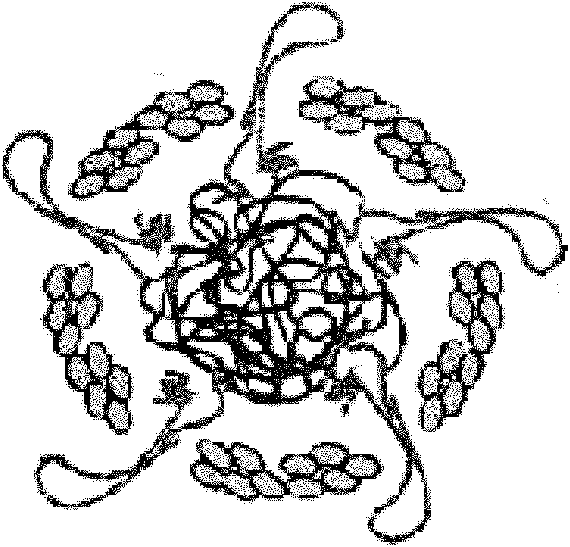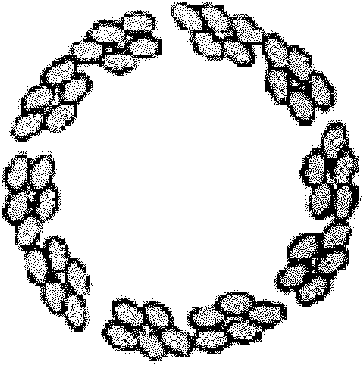Vaccine for chimeric virus-like particles and preparation method thereof
A chimeric virus, virus-like technology, applied in antiviral agents, chemical instruments and methods, hybrid peptides, etc., can solve problems such as low neutralization activity
- Summary
- Abstract
- Description
- Claims
- Application Information
AI Technical Summary
Problems solved by technology
Method used
Image
Examples
preparation example Construction
[0106] The method for preparing the above-mentioned virus-like particle VLP specifically comprises the following steps: 1. Constructing a chimeric gene expressing the above-mentioned protein. 2. Construct the expression plasmid containing the chimeric gene. 3. Construction of recombinant bacmid. 4. Obtain the expression system. 5. Express and purify the obtained chimeric protein. 6. Aggregating the above-mentioned chimeric proteins to make virus-like particles.
[0107] The capsids of the invention are used in the production of L1-capsid vaccines (virus-like particles). Production of L1-capsid vaccines can use, for example, the baculovirus expression system.
[0108] The present invention includes capsid mixtures containing two or more of the aforementioned capsids of the present invention. The three types of capsids of the present invention each have different cross-reactivity, and by mixing two or more types of capsids having different cross-reactivity, there is an adva...
Embodiment 1
[0123] 1.1 Production of rabbit peptide antiserum
[0124] Two New Zealand rabbits (2.5kg-3.0kg) were immunized. The antigen used is obtained by combining chemically synthesized peptide with KLH (keyholelimpet hemocyanin). The first sensitization was by subcutaneous administration of 0.5 mg of antigen with Freund's complete adjuvant. 0.25 mg of antigen was administered subcutaneously with Freund's complete adjuvant 2 weeks after the first administration. Then, sensitization was performed in the same manner (0.25 mg) after 2 weeks, 4 weeks, and 6 weeks, and sensitization was performed 5 times in total. One week after the last sensitization, whole blood was collected to obtain serum.
[0125] Antisera obtained by immunizing rabbits with a synthetic peptide having the amino acid sequence of the HPV16 type E7-surface region were examined using the neutralization experiment shown below. The results are shown in Table 1. From the results shown in Table 1, it can be seen that th...
Embodiment 2
[0132] Embodiment 2 Preparation of chimeric genes and chimeric VLPs
[0133] 1. Use the known HPV16L1 gene sequence retrieved from Genebank to synthesize the full sequence to obtain the L1 gene, and design HPV16-specific primers to amplify the full-length L1 gene. In order to facilitate the cloning of the target gene into the baculovirus donor plasmid, BamHI and EcoRI restriction site recognition nucleotide sequences were respectively introduced into the upstream and downstream primers. PCR technology was used to amplify, and the recovered HPV16L1 PCR product was connected to the pGEM--T carrier, and positive clones were screened by blue and white spots, and the positive clone plasmids were extracted, and the HPV16L1 sequences in the positive clones were sequenced at the same time.
[0134] The known gene fragment of the corresponding epitope protein of HPV16 type E7 was retrieved from GeneBank, and the gene fragment of the corresponding epitope protein of HPV16 type E7 was sy...
PUM
 Login to View More
Login to View More Abstract
Description
Claims
Application Information
 Login to View More
Login to View More - R&D
- Intellectual Property
- Life Sciences
- Materials
- Tech Scout
- Unparalleled Data Quality
- Higher Quality Content
- 60% Fewer Hallucinations
Browse by: Latest US Patents, China's latest patents, Technical Efficacy Thesaurus, Application Domain, Technology Topic, Popular Technical Reports.
© 2025 PatSnap. All rights reserved.Legal|Privacy policy|Modern Slavery Act Transparency Statement|Sitemap|About US| Contact US: help@patsnap.com



